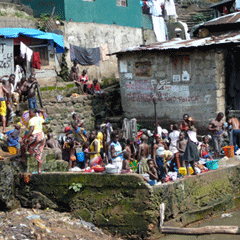By Lawrence Haddad

|
| Freetown, Sierra Leone. Photo: Andrea Merrick/Cities Alliance |
So what? Well, urban poverty challenges the development community in several ways. For a start, most development professionals have been trained in rural development and rural livelihoods. As we are so fond of saying, context is everything; whether we are equipped to face the different challenges of urban contexts is another question.
So how is urban development different? There's not enough research to be definitive, but there are plenty of plausible hypotheses.
One is that urban areas capture wide extremes of wealth and poverty, which often exist cheek by jowl. Urban averages hide deprivation on a scale rarely seen in rural areas.
Conflict and security in urban areas are also different, with violent civic conflict (pdf) – gangs, organised crime, terror and riots – much more of a problem. Urban policing and security models also differ.
Another point of divergence is that, in recently settled urban areas, informal ties and reciprocities are likely to be more fragile. This is because, in a more mobile context, the ties that bind take time to settle. Informal safety may well be weaker. Poverty targeting, which so many cash transfer programmes rely on, will be more complicated due to a greater mobility of residence. Access to urban health services requires the development of new relationship networks.
Institutional complexity is likely to be higher in urban areas, with more competition between various types of formal and informal sources of authority and more policy caution in the face of the threat of riots.
Access to services may appear enhanced in urban areas, but often their quality is uneven and the competition for them is intense. As David Satterthwaite has put it (pdf): "Having access to a pit latrine is not the same in a rural setting where it is used by one family and can be sited to avoid contaminating water sources, and urban settings where 50 households share it and where there is so much faecal matter that it is very difficult to protect water sources from contamination."
Poor urban dwellers have to deal with high levels of pollutants, toxicity and traffic-related injuries. And diet-related, non-communicable diseases tend to be a bigger problem in urban areas because of the availability of street foods.
Urban hazards are likely to hit harder because of population densities, so disaster-proofing urban planning and infrastructure is vital in promoting urban resilience.
The urban poor tend to buy a bigger share of their food than rural dwellers, hence their hunger and malnutrition is more dependent on growing and volatile food price levels.
Information communication technologies have a higher penetration rate in urban areas, offering all kinds of opportunities and risks for development processes and programmes.
Of course, there are many types of urban context – large/small town, capital/secondary city, urban/peri-urban, informal/formal dwelling and recent/long-term residents – and I am grossly simplifying things by conflating them (Satterthwaite has a nice "health warning for generalisers" at the end of this report (pdf).
I'm also using words such as "likely", "may" and "can be". This is me hedging my bets, simply because there is relatively limited research on urban poverty. If a quarter of all African poverty is urban, I'm guessing that less than a quarter of all recent African poverty research is urban.
Development organisations have been quite slow to pick up on the growing urban realities (and the Institute of Development Studies, of which I am director, is no exception) and have not developed urban thinking or urban programmes sufficiently well. The UK's Department for International Development is reportedly gearing up its urban thinking, which is welcome.
The sooner we begin analysing and understanding the diversity of urban contexts, the sooner we will understand how to reduce this growing and relatively neglected share of poverty in a sustainable way.
Posted by
This article was posted by Lawrence Haddad on 5 October as part of the Guardian’s series on Cities and Development.




